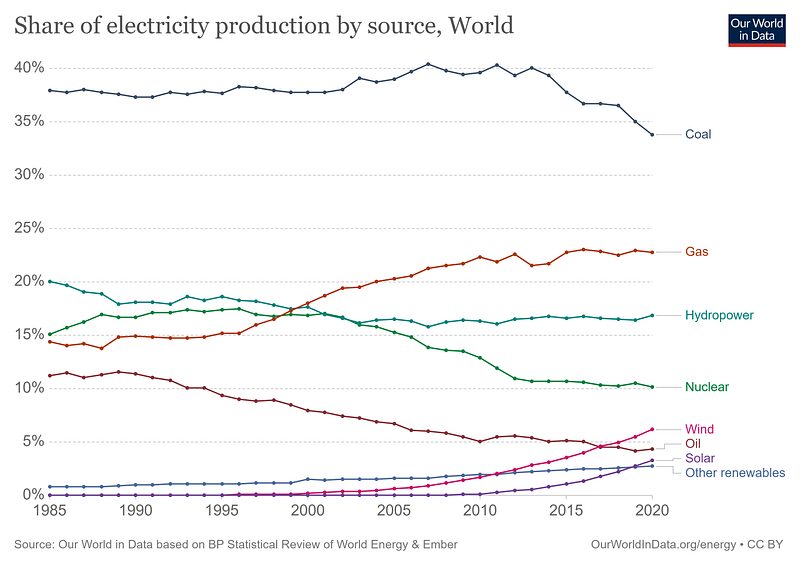The Future of Green Energy: What Will Come Next?
Written on
The Evolution of Renewable Energy
Renewable energy has undergone a tumultuous path toward widespread acceptance. In 1979, President Jimmy Carter made a notable decision by installing 32 solar panels on the White House, a part of a larger initiative aimed at achieving energy independence. However, given the technology of that time, these panels were inefficient, primarily serving to heat water for laundry and cafeteria use. Despite this, many experts believed that solar energy was on the verge of significant growth. That same year, the Energy Information Administration forecasted a remarkable expansion in solar energy, which in reality took decades to realize.
When Ronald Reagan assumed the presidency in 1981, he ordered the removal of the solar panels, leading to a stagnation in the budding solar industry for several years. The landscape began to shift in 1990 with the release of the first IPCC report, which highlighted the urgent issue of climate change. Initial responses from policymakers were lukewarm; Finland and Poland were the first to implement carbon taxes that year. However, as time progressed, climate policies began to gain momentum, culminating in the signing of the Kyoto Protocol in 1997, which encouraged more nations to adopt climate measures.
By the early 21st century, both wind and solar energy started to regain traction. In 2003, President George W. Bush reinstated solar panels at the White House, symbolizing a renewed interest in these energy sources, although actual advancements remained limited. At that time, wind energy contributed a mere 0.4% to global electricity generation, while solar accounted for just 0.01%. Coal still dominated the energy landscape, supplying over 39% of global electricity.
The past two decades have witnessed a remarkable transformation. Between 2009 and 2019, the cost of solar energy plummeted by 89%, while wind energy costs decreased by 70%. Once regarded as costly novelties, solar and wind energy have now become some of the most affordable energy sources available. Their declining prices have led to a growing contribution to the energy grid, with solar and wind together accounting for over 9% of global electricity production, while coal's share has decreased to 34%. With prices continuing to fall, these trends are likely to persist.

Emerging Contenders in Renewable Energy
As renewable options expand, the potential exists to completely phase out coal and natural gas from the energy mix. Which energy sources might emerge as the frontrunners?
One contender is geothermal energy, which harnesses heat from beneath the Earth's surface. Unlike solar and wind, geothermal energy can provide a steady and reliable output, with minimal seasonal variation. New geothermal plants can adjust their output to match fluctuating demand, making them a valuable asset in a grid increasingly reliant on intermittent energy sources. In 2019, the global geothermal capacity saw a record addition of 0.9 GW, reflecting growing momentum for this energy source.
However, geothermal energy still plays a minor role in the global energy landscape, accounting for less than 1% of total production. Although it remains cost-competitive, it hasn't experienced the same rapid advancements seen in solar and wind technologies. The U.S. Department of Energy projects that geothermal could supply 8.5% of U.S. electricity by 2050 if technological improvements are realized.
Hydropower, despite its long-standing presence in energy generation, also shows potential for future growth. It currently provides nearly one-fifth of the world's electricity but has been somewhat overlooked by environmental advocates. A recent report from the International Energy Agency revealed that only half of the economically feasible hydropower resources are currently being utilized. Unlike wind and solar, hydropower offers the ability to store energy for extended periods, positioning it as a complementary resource to other renewable sources.
Innovative technologies are also emerging that leverage water for energy. Tidal power captures the energy from ocean tides, while wave energy converters harness the power of ocean waves.

Despite the potential of tidal and wave energy, commercial adoption remains limited, largely due to high costs and the dominance of wind and solar technologies. Concentrated Solar Power (CSP) represents another promising avenue. Unlike traditional photovoltaic solar panels that generate energy from sunlight, CSP relies on heat, making it easier to integrate with energy storage systems like molten salt towers, which can provide storage for up to 15 hours. Although sidelined in recent years, CSP still holds considerable future potential.
The outlook for renewable energy remains uncertain, yet the International Renewable Energy Agency's 2018 report suggests that by 2050, up to 85% of electricity generation could come from renewable sources. The agency forecasts a mix dominated by wind (36%), solar (22%), and hydropower (12%), while also recognizing the contributions of CSP (4%) and geothermal (3%). Emerging technologies, categorized as "others," which include marine energy solutions, could represent an additional 4%.
The future of energy technology is unpredictable. Just three decades ago, few anticipated the explosive growth of wind and solar energy. However, with a wide array of both established and emerging technologies vying for attention, further advancements in renewable energy are likely inevitable.
Explore the best renewable energy sources in this insightful video that discusses the effectiveness and potential of various options.
Uncover the truth about renewable energy sources in this video, which delves into the facts and myths surrounding these technologies.
If you wish to connect with me, feel free to reach out on Twitter.